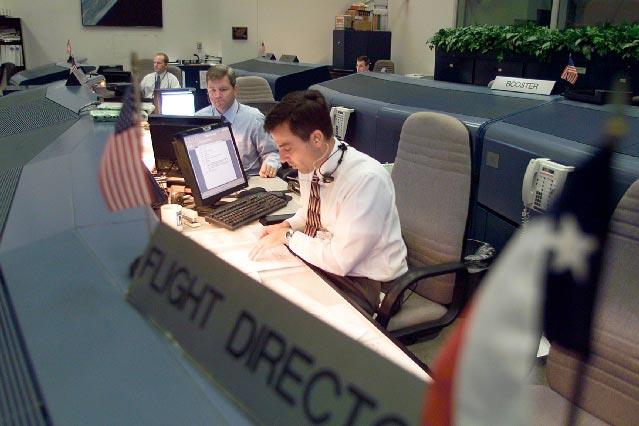STS-114: Discovery Astronauts, Flight Controllers Simulate ISS Docking

Aswarm of NASA flight controllers, astronauts and engineers have reached onestep closer to returning to space agency's shuttle program to launch status,performing the first of many full-scale simulations for its firstreturn-to-flight mission.
Withtheir feet planted firmly at NASA's Johnson Space Center (JSC) in Houston,Texas, flight controllers and the astronaut crew for the Discovery STS-114mission conducted an eight-hour simulation of the shuttle's rendezvous anddocking with the International Space Station (ISS).
Spacestation astronauts also participated in the docking dress rehearsal, whichincluded a run through of the new shuttle pitch maneuver that will give ISScameras and crew a good view of Discovery's belly-mounted ceramic heat tiles.That roll maneuver adds about 20 minutes to the already lengthy dockingprocess, but will likely become standard procedure for future missions to theISS, NASA officials said.
"Forme, this is the light at the end of the tunnel," Paul Hill, lead flightdirector at JSC, told SPACE.com. "We have spent a lot of effortinvestigating the [Columbia] accident and doing the engineering work to changehow we're going to fly."
NASA'sthree remaining space shuttles have been grounded since the Feb. 1, 2003 lossof Columbia and its seven-astronaut crew during reentry. The shuttle's leftwing leading edge was damaged during launch and its crew was unable to surveythe damage up close while in orbit.
ButNASA engineers are working to change that. During Discovery's ISS dockingsimulation, its astronaut crew, ISS counterparts and ground flight controllerswent through a series of flight maneuvers - in addition to rendezvous pitch -designed to survey NASA orbiters in flight. A second dress rehearsal plannedfor this week includes using an orbital boom, still under development by NASAengineers, that will allow Discovery's crew to look up close it the shuttle'swing leading edges and nose cap.
"Thefact that we're able to do these simulations now shows that many of themilestones for return to flight have been completed," said STS-114 missionspecialist Andrew Thomas. "We're getting the rhythm of flying the shuttleagain and that's kind of a nice feeling to have."
Breaking space news, the latest updates on rocket launches, skywatching events and more!
TheOct. 13 full-scale simulation began on Day Three of Discovery's STS-114 flightplan, starting just after the wake-up call for mission commander Eileen Collinsand her crew. The mock shuttle-ISS mission ran through the Day Three timelineuntil about an hour after ISS docking.
"Thisintegrated simulation is a huge milestone for the crew," Collins said."The crew is ready to go, the flight control team is ready to go, andwe're especially looking forward to the rendezvous pitch maneuver -- somethingthat's never been done before."

Tariq is the award-winning Editor-in-Chief of Space.com and joined the team in 2001. He covers human spaceflight, as well as skywatching and entertainment. He became Space.com's Editor-in-Chief in 2019. Before joining Space.com, Tariq was a staff reporter for The Los Angeles Times covering education and city beats in La Habra, Fullerton and Huntington Beach. He's a recipient of the 2022 Harry Kolcum Award for excellence in space reporting and the 2025 Space Pioneer Award from the National Space Society. He is an Eagle Scout and Space Camp alum with journalism degrees from the USC and NYU. You can find Tariq at Space.com and as the co-host to the This Week In Space podcast on the TWiT network. To see his latest project, you can follow Tariq on Twitter @tariqjmalik.
